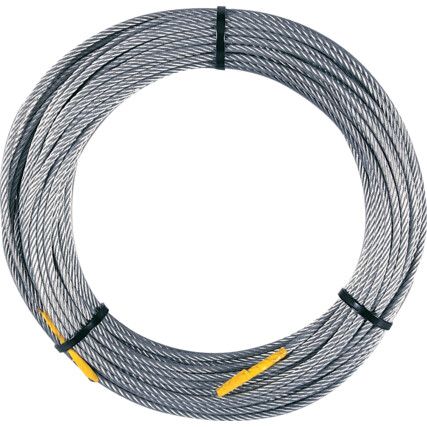Wire Ropes
When securing, hoisting, bracing or lifting heavy machinery, wire ropes are a crucial tool to ensure a sturdy hold every time. Here at Cromwell, we have a wide range of wire ropes from trusted leading brand TTC Lifting.
What is wire rope?
Wire rope - sometimes also called cable - is a length of usually steel material, formed from multiple strands of metal wire wound together to make a durable and extremely strong rope.
When is wire rope used?
Most commonly used in the industrial, automotive and construction industries, wire rope is often utilised in the transmission of mechanical power to help manoeuvre levers as well as larger mechanisms such as cranes, elevators and large machinery. Wire rope is extremely versatile and can be used to hoist, lift, repair, secure and even brace items in a specific position if necessary.
Considerations when choosing wire rope
• Length - Depending on your specific requirements, you may require a short or long length of wire rope. Our range of wire rope is sold in 20, 50 or 100 metres to ensure you have the right length to suit your needs.
• Material - Although most wire rope is normally made from steel - either Stainless or Galvanised - sometimes the grade of steel can vary as well as the material itself. It is always best to research into the most appropriate grade and material of wire rope for your application before purchasing.
• Diameter - Wire rope is available in a wide range of diameters and it's important to be sure you properly identify the correct diameter of rope needed to ensure safe usage and a strong hold on your desired item.
Wire rope jargon buster
We want to make it easy for you to shop our range of wire ropes, so here are some key terms that will help you understand the range and applications a little better.
What is the difference between Elastic Stretch and Structural Stretch?
Wire ropes are subject to two types of stretch: Elastic and Structural.
Elastic Stretch is defined as the elongation of the individual wires that make up the rope when under load.
Structural Stretch refers to the lengthening of the lay - the position and direction of the stranding in the rope - as the individual wires adjust when under load.
So how do I calculate Cable Stretch?
To calculate an approximation of cable stretch, the following formula must be used: (E= (W x G) / D2)
Below, the letters in the formula are broken down to help you better understand the calculation.
E: Elastic stretch as a % of length
W: Weight or load in pounds (lbs)
D: Diameter of wire rope in inches
G: Stretch Factor
FAQs
Does wire rope stretch?
Wire rope does indeed stretch and is subject to two kinds of stretch: Structural and Elastic Stretch as outlined above. It's always advised to use the above formula to calculate the stretch of your desired wire rope to factor this into your purchasing decision and make sure you find the best product for your application.
Is wire rope strong?
Wire rope is made from a continuous length of steel with multiple strands twined together for bolstered strength. The strength of wire rope is determined by the wire ropes 'Breaking Load' or 'Breaking Strength'. This can be increased or decreased depending on a number of factors, including the rope diameter and the rope material.
Can wire rope be welded?
Welding lengths of wire rope together is common in the industrial sector and when done correctly, can be an effective way of forming a longer, continuous length of wire rope. It's always best to check that the wire rope is 100% stainless steel in its construction first; if there is any other materials enmeshed between the individual strands of metal wire such as an adhesive, vinyl or fabric rope threads, then these will burn away when attempting to weld and make sully the end result and reduce the overall strength of the wire rope.
